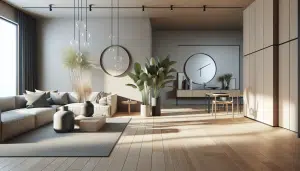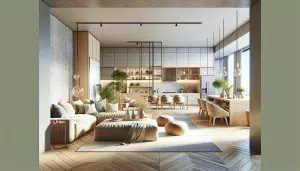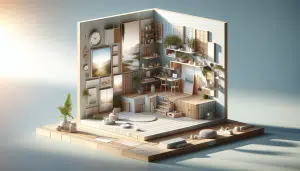Trends You Will See in Home Decor and Living Spaces
Lily Carter October 22, 2025
Curious about the hottest changes in home decor that inspire comfortable and stylish living? Learn how trending home design ideas, sustainable materials, and creative space solutions can transform any living space. This guide explores what’s shaping modern interiors.
Embracing Biophilic Design for Healthier Living
Biophilic design is all about bringing natural elements into your home for a calming and energizing space. This trend involves incorporating natural light, greenery, wood textures, and stone surfaces—creating environments that foster well-being and relaxation. Plants are more than decoration; they contribute to cleaner indoor air and a welcoming atmosphere. Hanging plants, vertical gardens, or a simple vase of fresh flowers near windows can make a difference. More people opt for this style as research continues to reveal the benefits of connecting with nature indoors.
Other biophilic elements include water features, organic materials, and earthy color palettes that reflect the outdoors. Large windows, skylights, and glass doors help maximize daylight, which can improve mood and productivity. Open shelving with clay pots and stone bowls accentuates the natural vibe. This move toward nature-inspired living supports mindfulness and encourages more time spent in restful settings. People seeking tranquility opt for forest greens, terracotta, and soft neutrals to evoke calmness and connection to the environment.
The practical impact of biophilic design is growing. Studies highlight links between indoor greenery and reductions in stress, fatigue, and anxiety. For city dwellers, this approach offers a retreat without traveling far. Biophilic accents suit all types of spaces, from compact apartments to large homes. Collect ideas from magazines or sustainability-focused design blogs, and see how elements like bamboo or cork flooring and woven baskets can refresh the spirit of a room while reducing environmental impact. These small changes can lift any living space.
Multifunctional Spaces: Making the Most of Every Room
Modern lifestyles increasingly require adaptable spaces that serve multiple purposes. The rise of remote work and hybrid schedules means living rooms or bedrooms double as offices, gyms, or creative studios. Flexible furniture—such as fold-out desks, sleeper sofas, convertible tables—is in high demand. Hidden storage solutions maintain order and support minimalism. Designing for flexibility supports dynamic routines and helps manage clutter for a tidier, more functional home environment. This trend is especially relevant in urban dwellings with limited square footage.
Multipurpose design isn’t just about saving space; it’s about supporting diverse activities without sacrificing style or comfort. People experiment with decorative dividers to create visual boundaries or use color zoning to designate work, rest, and social areas within a single room. Nesting tables, poufs, and mobile carts offer extra surfaces only when needed. Smart organization like wall-mounted shelves and modular systems maximize vertical space. This creative approach allows even small apartments to feel more open and versatile.
A number of home design platforms feature examples of flexible spaces customized for specific needs, such as workout zones that transform into reading nooks or kitchen counters that act as meeting desks. Homeowners can draw inspiration from tiny home communities where space-saving tricks are essential. Even traditional homes are reimagined with pocket doors, Murphy beds, and built-in benches with hidden compartments. Ultimately, multifunctional spaces empower residents to make the most of every inch, supporting both productivity and leisure.
Sustainable Materials and Eco-Friendly Home Decor
Sustainability continues to shape home decor in new and exciting ways. Many people now select materials carefully, opting for furnishings made from recycled, reclaimed, or responsibly sourced resources. Shoppers look for certifications from reputable organizations that guarantee wood, textiles, or paints meet environmental standards. Furniture crafted from bamboo, recycled metals, or salvaged wood is gaining notice—not just for its environmental benefits but also for unique textures and stories. Thoughtful decor choices contribute to reduced waste and more ethical supply chains.
Eco-friendly decor extends to the smallest details—think reusable storage bins, natural-fiber rugs, and non-toxic paints. Vintage and secondhand finds are prized for their charm and sustainability. Many embrace circular design principles, which prioritize durability, repairability, and minimal environmental impact across a product’s lifespan. People appreciate brands that upcycle old items into modern treasures or offer take-back programs for used goods. This mindset fosters a home that is stylish, comfortable, and conscious of its environmental footprint.
Even with a modest budget, adopting sustainable practices is possible. Simple swaps—like beeswax candles instead of paraffin or ceramic planters in place of plastic pots—add eco-flair. Bringing nature indoors with potted plants or herb gardens encourages sustainable living habits and cleaner air. Upgrade lighting fixtures to energy-efficient LED bulbs to save resources over time. As awareness grows, more homeowners take steps to ensure their living spaces nurture both people and the planet. These small changes can inspire friends and visitors alike.
Personalization and Storytelling Through Interior Design
Today’s trendsetters value personal expression in every corner of their homes. Instead of following one strict style, people blend travel mementos, family heirlooms, original artwork, and custom-made pieces to tell their stories. Mixing high-contrast styles—like modern with vintage, or minimal with maximal—results in visually interesting, meaningful spaces. Gallery walls filled with personal photos or curated art prints become focal points that spark conversation and add warmth. Choosing decor that reflects personal milestones supports emotional connection to the home.
Many individuals also gravitate toward DIY projects as a way to add unique flair. From hand-painted murals to upcycled furniture, these touches showcase creativity and resourcefulness. Social platforms provide endless inspiration—think videos on refinishing old chairs or tutorials for making custom shelving. Layering in diverse textures, colors, and souvenirs collected from travels gives rooms depth. This approach ensures that spaces remain dynamic, evolving with residents’ tastes and experiences over time.
The psychology of personalized design points to increased happiness and contentment where individuality is celebrated. Having a home that feels truly personal can reduce stress and create a sanctuary. Accent pieces—like vintage rugs, bold-patterned statement cushions, or locally made ceramics—can tell a story while supporting artisans and small businesses. This trend proves that interior design is as much about self-expression as aesthetics. Through mindful selection, every item tells part of a larger narrative.
Smart Home Tech Blends Comfort and Convenience
Technology is rapidly redefining how comfort, convenience, and security are experienced at home. Smart devices—from voice-enabled speakers to automated lighting, connected thermostats, and app-controlled appliances—are more accessible than ever. Integrated home systems allow residents to adjust settings or monitor their spaces remotely. These innovations provide both energy savings and streamlined routines. The focus has shifted toward user-friendly devices that blend seamlessly with decor, ensuring tech supports rather than disrupts the home’s style.
For many, energy-efficient upgrades like smart LED bulbs or programmable window shades are the first step toward a tech-optimized home. These tools can regulate temperature or lighting based on daily routines, improving comfort and lowering bills. Security enhancements—such as doorbell cameras or motion-sensor alarms—provide peace of mind and fit neatly into most home designs. Smart speakers and appliance hubs simplify entertainment, letting users manage music, news, or movies with simple voice commands. Customizing device settings ensures a personalized home experience.
Smart tech goes beyond gadgets by supporting healthier lifestyles. Air quality monitors, water-saving showerheads, and automatic plant irrigators address specific household needs. For those with accessibility challenges, voice control and automation open new possibilities for independence. Importantly, experts recommend balancing digital convenience with privacy awareness—choosing secure systems and following recommended guidelines. As smart homes become more common, integrating technology thoughtfully ensures homes remain welcoming, efficient, and user-focused.
Color Trends and Textures That Set the Mood
Color choices and tactile elements have a profound effect on mood, energy, and the ambiance of any room. Current trends highlight earthy tones—warm creams, deep greens, dusty blues, and muted terracottas—influenced by nature. These shades create inviting environments that encourage relaxation. Layering in bold accent colors, like mustard or teal, can inject personality and interest. Homeowners are experimenting with color blocking, painted ceilings, and two-tone walls to achieve playful yet sophisticated looks.
Textures contribute dimension and comfort. Mixing materials—think chunky knits, sleek metals, natural wood, soft velvets, or woven rattan—brings energy and visual variety. Tactile details, such as fringe on cushions or raised wallpaper patterns, make spaces feel more inviting. Rugs, throw blankets, and textured ceramics provide warmth and softness. The interplay between smooth and rough, shiny and matte, can guide how a room feels throughout the day. A well-balanced mix is key to enduring satisfaction.
Color and texture trends evolve with cultural shifts and advances in material innovation. Experts suggest observing how natural light impacts chosen palettes before committing to big changes. Incorporating seasonal touches—like lightweight linens in summer or cozy wool in winter—helps refresh rooms throughout the year. By favoring colors and materials that resonate with personal taste, individuals build uniquely comforting spaces. It’s this thoughtful attention to atmosphere that creates a memorable home environment.
References
1. Kellert, S. R., Heerwagen, J., & Mador, M. (2008). Biophilic Design: The Theory, Science and Practice of Bringing Buildings to Life. Retrieved from https://www.taylorfrancis.com/books/mono/10.4324/9780080553493/biophilic-design-stephen-kellert-judith-heerwagen-martin-mador
2. U.S. Environmental Protection Agency. (n.d.). Indoor Air Quality and Plants. Retrieved from https://www.epa.gov/indoor-air-quality-iaq/indoor-air-quality
3. The Green Building Council. (n.d.). Sustainable Materials for Interiors. Retrieved from https://www.usgbc.org/articles/green-materials-interior-design
4. American Society of Interior Designers. (2022). Interior Design Trends. Retrieved from https://www.asid.org/resources/glossary
5. Harvard Health Publishing. (2019). The Benefits of Indoor Plants. Retrieved from https://www.health.harvard.edu/staying-healthy/the-benefits-of-indoor-plants
6. National Renewable Energy Laboratory. (n.d.). Energy Efficiency in Home Design. Retrieved from https://www.nrel.gov/buildings/energy-efficiency-home-design.html







